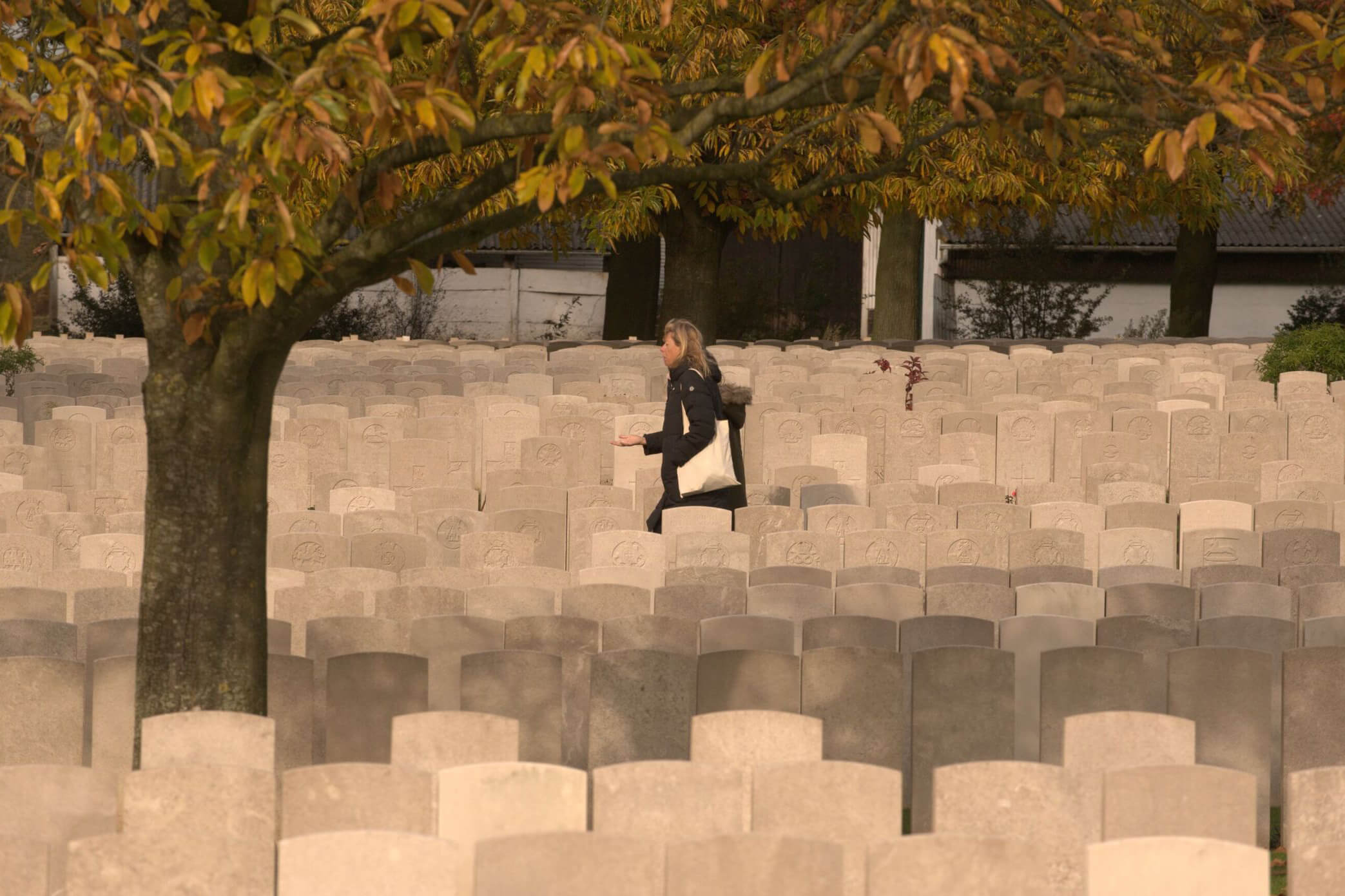Tackling staining on our headstones – an update - 26 November 2025

Some of our headstones in cemeteries across France and Belgium have developed dark staining. These marks are not simply surface dirt, they’re caused by tiny photosynthetic and fungal organisms that thrive in all weather conditions. Some produce dark pigments that settle deep into the stone, making them hard to remove.
While older chemical-based cleaning products masked the problem and appeared effective in the short term, they did not prevent regrowth and may have made the stone more prone to future staining. Our current approach avoids harsh chemicals to better protect the stone, but it cannot fully remove the marks.
We are actively committed to finding an effective long term sustainable solution. We appreciate your patience as we work with scientists. Together we are determined to find the answer to this complex problem.
We would like to thank those who brought this important issue to our attention, helping us ensure we give it the attention it deserves.
Autumn update from our Director of Estates
Between September and November 2025 our regular autumn cyclical maintenance programmes were strengthened with additional headstone cleaning across France and Belgium, focusing particularly on removing the black staining caused by a specific biological growth.
All headstones in the Ypres Salient were treated with an enzyme-based product. Biocides were carefully and selectively reintroduced at badly affected sites as a short-term measure, with appropriate permissions in Belgium and in severely affected cemeteries in France. We continue to constantly monitor the condition of all our headstones.
Trials continue for sustainable cleaning products and processes, including steam cleaning, limewash, laser and enzyme variants. During this period some treatments were tested but not progressed. Research collaborations with the Universities of Antwerp, Ghent, and two UK institutions are advancing well and are expected to provide deeper insight into microbial staining.
A full review is planned for Spring 2026, with a progress webinar scheduled ahead of this in early 2026.
As we move into winter, our cemetery cycle maintenance care will include measures to focus on seasonal maintenance including managing flooding and storm damage and repairing freeze–thaw effects on stonework.
Here, Senior Estates and Heritage Manager, Wim Pira, talks from Hooge Crater Cemetery on the methods we’ve used and are trialling to clean headstones in Belgium.
Please note: You must accept cookies in order to display the video.
Keep up to date with our webinars
Following the warm reception to our previous webinar, we are planning another in the New Year to discuss the ongoing work on headstone staining and our winter site maintenance. Keep an eye on our channels for the date and sign up details.
Further information – dark staining on headstones
The staining is caused by biological colonisation - a living microbial biofilm that includes green algae, lichens, and fungi (such as Cladosporium and Alternaria). These organisms grow in humid conditions and penetrate both the surface and subsurface of the stone.
Thanks to the efforts of our regional teams and reports from our supporters and visitors to our sites, we have now started treating affected headstones at around 100 sites in France and Belgium. We also put up signs at many of the sites affected earlier in the autumn.
A full survey of our estate is ongoing and we continue to monitor treatment at the cemeteries affected.
Absolutely not. We're actually spending more than ever on solutions that meet our needs, are safe for our people, and respect the environment.
We continue to receive strong support from our Commonwealth member states and are staffed by a dedicated and skilled workforce. However, this issue is a unexpected challenge. We are actively working alongside scientific experts to develop an effective solution.
Our headstones are regularly cleaned, both seasonally and as needed. However, the recent growth we're seeing is different from what we've previously encountered, and our current cleaning methods are not fully effective against it.
We would like to emphasise that the challenges currently affecting some of our sites are not the result of neglect, under-resourcing, or a change in our long-standing commitment to sustainability. Rather, the withdrawal of chemicals, including biocides which are now prohibited in many countries around the world, combined with climatic changes in recent years, has made our operations increasingly challenging across parts of northern Europe, but we do maintain the same core aim of appropriate ‘care’ for all our cemeteries - that has not changed, nor will it.
Autumn cleaning addressed the general cleanliness of headstones as part of our normal cycle for this time of year, but also tackled the black staining caused by biological growth. All headstones in the Ypres Salient were treated with our enzyme-based product and headstones across France were treated based on need, applying different cleaning products and processes.
Our previous cleaner was a biocidal product that masked biological growth using a chemical bleaching effect. While effective at masking the issue, it raised environmental concerns.
Our current product is chosen to be less harmful to the environment, but it is not as effective at removing the deep staining.
In two cemeteries in Belgium special permission was obtained to return to biocide use. In France, biocide use was limited to sites where staining was severe, and its use was tightly controlled and temporary.
Site inspections are planned to confirm the efficacy of the cleaning, and when satisfied we will remove the temporary signage explaining to visitors that the site is not up to our usual standards.
Several methods are under evaluation. They are sustainable and reduce chemical use, and are:
- Steam-based techniques (strong results in UK trials).
- Limewash applications trialled on limestone headstones for compatibility and stain resistance.
- Laser and UV-C (Ultraviolet-C) for long-term viability.
- Enzyme variants trialled in UK and Europe to improve performance.
Yes, dry ice cleaning and natural oil treatments due to limited effectiveness.
Yes, with the University of Antwerp & Ghent for DNA sequencing. Two UK universities are working with us to deepen understanding of microbial staining and inform future solutions.
All treatments and trials logged with photographic evidence for ongoing assessment.
A comprehensive Spring 2026 review planned to evaluate autumn outcomes and refine approaches for sustainable headstone care. We will share this plan in a webinar in early 2026.
We care for our global sites year-round, adapting to seasonal conditions to preserve their dignity and accessibility.
In the Northern Hemisphere, winter can bring challenges such as freezing temperatures, heavy rain, storms, and flooding. Our teams implement seasonal horticultural strategies, including leaf clearance, and address the impact of freeze–thaw cycles on stonework, which can be a significant issue. Sites vulnerable to flooding are monitored closely and where possible drainage improvements and water diversion measures are installed. Local teams are trained to respond quickly and safely to any weather-related damage including clearing up after storms.
In the Southern Hemisphere, our focus shifts to managing warmer and wetter conditions, such as monsoon rains or prolonged dry spells, ensuring our sites remain cared for whatever the climate.

Please contact our customer service team, who will be able to help you with any questions about our headstone maintenance and other areas of our work.
If you would like to report a specific headstone or cemetery to us, please do send us photos, including the date the photo was taken.
Contact Us
